Module 16 − Introduction to Test Equipment
Pages i,
1−1,
1−11,
1−21,
2−1,
2−11,
2−21,
3−1,
3−11,
3−21,
3−31,
4−1,
4−11,
4−21,
5−1,
5−11,
5−21,
5−31,
6−1,
6−11,
6−21,
6−31,
6−41, Index
Summary The important points of this chapter are summarized in the following paragraphs. You should be familiar
with these points before continuing with your study of test equipment. A permanent-magnet, moving-coil
meter movement (D'ARSONVAL movement) uses the interaction of magnetic fields to produce movement.
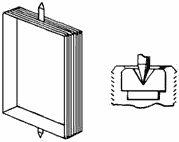
DAMPING is used to smooth out the vibration and to help prevent overshooting of the
meter pointer.
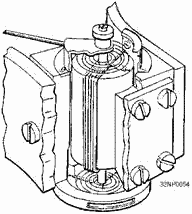
ELECTRODYNAMOMETER movements are usually used in wattmeters. They operate much like the
D'Arsonval meter movement, except field coils are used instead of a permanent magnet. Electrodynamometer movements
measure either ac or dc without the use of a rectifier.
3-31
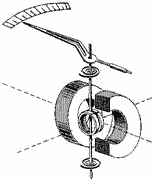
A Shunt is a physically large, low-resistance conductor connected in parallel with the
meter terminals. It carries the majority of the load current so that only a small portion of the total current
will flow through the meter coil. An AMMETER measures current and is always connected in
series with the circuit being measured. An ammeter should have a low resistance so that the effect of the ammeter
on the circuit will be kept to a minimum. VOLTMETERS are used to measure voltage and are
always connected in parallel with the circuit being measured. a voltmeter should have a high resistance compared
to the circuit being measured to minimize the loading effect. Voltmeter sensitivity is expressed in ohms per volt.
OHMMETERS are used to measure resistance and to check continuity. An ohmmeter is electrically
connected in series with the resistance being measured. The ohmmeter range, which allows a midscale deflection,
should be used.
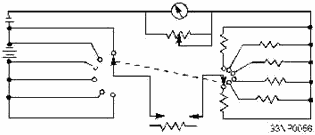
A MEGOHMMETER (MEGGER) is used to measure very high resistance, such as the insulation
of wiring. A WATTMETER is usually an electrodynamometer and is used to measure power.
3-32
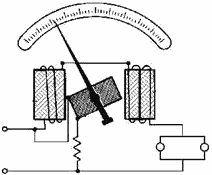
A CONTINUITY Test is accomplished with an ohmmeter. This test is used to check for
opens (or to see if the circuit is complete or continuous). Grounded Circuits are caused
by some conducting part of the circuit making contact either directly or indirectly with the metallic structure of
the ship or chassis. In testing for grounds, you may use either an ohmmeter or a megger. A Short
Circuit, other than a grounded one, is where two conductors touch each other directly or through another
conducting element. An ohmmeter is used to test for shorts. Answers to Questions Q1. Through Q29. A-1. Self-excited. A-2. Phosphor bronze ribbons.
A-3. The pointer arrangement and the light and mirror arrangement. A-4. Coil balance. A-5.
Hairspring. A-6. Hairspring. A-7. Makes it possible to have a more linear scale than if the
poles were flat. A-8. Shunt.
A-9. Zero-temperature coefficient. A-10. Midscale. A-11. In series. A-12.
Negative, positive.
3-33
A-13. False. A-14. Meter-loading. A-15. a multimeter (high resistance) is placed
in series with the coil of the meter. A-16. The current required for full-scale deflection, and the
range of the voltage to be measured. A-17. In parallel. A-18. High. A-19. Ohms per
volt. A-20. Megohmmeter (megger). A-21. 1. a source of dc potential. 2. One or more
resistors (one of which is variable). A-22. Zero. A-23. 1/10.
A-24. Shunts leakage current, which prevents false readings. A-25. 500.
A-26. Friction clutches. A-27. Fixed coils. A-28. Size of spiral conducting. A-29.
The electrodynamometer-type meter can be used to measure both ac and dc currents.
3-34
| - |
Matter, Energy,
and Direct Current |
| - |
Alternating Current and Transformers |
| - |
Circuit Protection, Control, and Measurement |
| - |
Electrical Conductors, Wiring Techniques,
and Schematic Reading |
| - |
Generators and Motors |
| - |
Electronic Emission, Tubes, and Power Supplies |
| - |
Solid-State Devices and Power Supplies |
| - |
Amplifiers |
| - |
Wave-Generation and Wave-Shaping Circuits |
| - |
Wave Propagation, Transmission Lines, and
Antennas |
| - |
Microwave Principles |
| - |
Modulation Principles |
| - |
Introduction to Number Systems and Logic Circuits |
| - |
- Introduction to Microelectronics |
| - |
Principles of Synchros, Servos, and Gyros |
| - |
Introduction to Test Equipment |
| - |
Radio-Frequency Communications Principles |
| - |
Radar Principles |
| - |
The Technician's Handbook, Master Glossary |
| - |
Test Methods and Practices |
| - |
Introduction to Digital Computers |
| - |
Magnetic Recording |
| - |
Introduction to Fiber Optics |
| Note: Navy Electricity and Electronics Training
Series (NEETS) content is U.S. Navy property in the public domain. |
|












